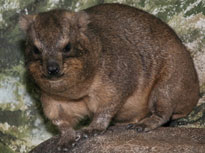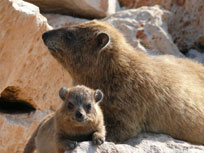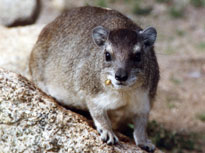Hyracoidea -- dimunitive elephants, perhaps



Origins
Hyrax (Hyrakos means shrew-mouse in Greek) are sometimes described as being the closest living relative to the elephant. This is because they may share an ancestor in the distant past when hyraxes were larger and more diverse. However, the details of their relationship has not been fully explored and verified.
All modern hyraxes are members of the family Procaviidae (the only living family within the Hyracoidea) and are found only in Africa and the Middle East. In the past, however, hyraxes were more diverse and widespread. The order first appears in the fossil record over 40 million years ago, and for many millions of years hyraxes were the only plant eaters( herbivores) in Africa. There were many different species, the largest of them about the weight of a small horse, the smallest the size of a mouse. During the Miocene, however, competition from the newly-developed antelopes and other very efficient grazers and browsers pushed the hyraxes out of the prime territory and into marginal niches. Nevertheless, the order remained widespread, diverse and successful as late as the end of the Pliocene (about two million years ago) with representatives throughout most of Africa, Europe and Asia.
The descendants of the giant hyracoids evolved in different ways. Some became smaller, and gave rise to the modern hyrax family. Others appear to have taken a shine to water (perhaps like the modern capybara), and ultimately gave rise to the elephant family, and perhaps also the Sirenians (dugongs and manatees). DNA evidence supports this hypothesis, and the small modern hyraxes share numerous features with elephants, such as toenails, excellent hearing, sensitive pads on their feet, small tusks, good memory, high brain functions compared to other similar mammals, and the shape of some of their bones.
Physical Characteristics
Hyraxes are all small to medium-sized herbivores (1.5-5 kg), with short legs, a bunny's tail, and round ears. They have a rabbit-like appearance, hence the vernacular name, "rock rabbit". Males and females are approximately the same size. Average size of adult Rock Hyraxes varies greatly across Africa, and seems to be closely linked to average annual rainfall. The plantigrade (standing on tiptoe) feet have rubbery pads with numerous sweat glands, and are not equipped for digging. While the animal is running, the feet sweat, which greatly helps its climbing ability. Species living in arid and warm zones have short fur, but Tree Hyraxes and species in alpine areas have thick, soft fur. Hyraxes have long hair widely distributed over their bodies, probably for orientation in dark fissures and holes. The pair of upper incisors are tusk-like (evidence of the whole elephant relationship issue) in males.
Geographic Distribution
View Larger Map
Hyraxes are endemic to Africa with the exception of the Bush Hyrax that is also found in Sinai and the Rock Hyrax that extends into the Arabian Peninsula from Lebanon to Saudi Arabia. Rock and Bush hyraxes are dependent on the presence of suitable refuges in rocky outcrops (kopjes) and mountain cliffs. They have the widest geographical and altitudinal distribution. Tree Hyraxes are found in arboreal habitats, but in the alpine areas of the Ruwenzori Mountains in Uganda and Congo, they are also rock dwellers. The Eastern Tree hyrax might be the earliest type of forest-living Tree Hyrax, being a member of the primitive fauna and flora of the islands of Zanzibar and Pemba in East Africa.
Reproduction
Rock Hyraxes have a very long pregnancy(about 7 1/2 months) compared to other rock-dwelling grass-eaters. The young are born fully developed and are weaned within a few months. Most hyrax live in family groups of one adult male and a group of females so as the females grow up they stay within the group while the males are kicked out by papa around their 30th month.
When the dominant male gets old or gets picked up by a predator, the other males that live around his territory claim the leadership of the group of females and young. It's a bit brutish, but that is a hyrax's life really. Carpe Diem, and all that you know.
Feeding Habits
Hyrax eat grass but unlike hooved creatures(antelopes and their ilk), do not chew cud. Instead they rely on bacteria within their three chambered stomach to extract nutrients from the vegetation that they eat. Hyrax have also been known to tuck into an insect snack or have a bird's egg or lizard once in a while. This information is spotty and cannot be really confirmed though.
Videos
Species within Order Hyracoidea and Family Procaviidae
Genus Dendrohyrax
Southern Tree Hyrax -- Dendrohyrax arboreus
Western Tree Hyrax, Dendrohyrax dorsalis
Genus Heterohyrax
Yellow-spotted Rock Hyrax -- Heterohyrax brucei
Genus Procavia
Rock Hyrax -- Procavia capensis